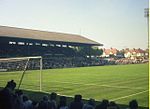Hove

Hove is a seaside resort and one of the two main parts of the city of Brighton and Hove, along with Brighton in East Sussex, England. Originally a "small but ancient fishing village" surrounded by open farmland, it grew rapidly in the 19th century in response to the development of its eastern neighbour Brighton, and by the Victorian era it was a fully developed town with borough status. Neighbouring parishes such as Aldrington and Hangleton were annexed in the late 19th and early 20th centuries. The neighbouring urban district of Portslade was merged with Hove in 1974. In 1997, as part of local government reform, the borough merged with Brighton to form the Borough of Brighton and Hove, and this unitary authority was granted city status in 2000.
Excerpt from the Wikipedia article Hove (License: CC BY-SA 3.0, Authors, Images).Geographical coordinates (GPS)
| Latitude | Longitude |
|---|---|
| N 50.8352 ° | E -0.1758 ° |
Address
BN3 3LW , Aldrington
England, United Kingdom
Open on Google Maps










